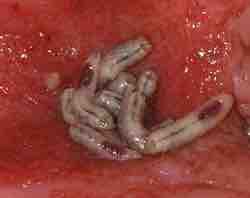A wide variety of chemicals called antimicrobial agents are available for controlling the growth of microbes. For example: 1. Chemotherapeutic agents, including antibiotics, are administered into the infected body. 2. Disinfectants are chemical agents used on inanimate objects to lower the level of microbes present on the object. These are not capable of sterilizing, typically because they fail to kill endospores, some viruses, and organisms such as Mycobacterium tuberculosis. 3. Antiseptics are chemicals used on living tissue to decrease the number of microbes present in that tissue.
Disinfectants and antiseptics affect bacteria in many ways. Those that result in bacterial death are called bactericidal agents. Those causing temporary inhibition of growth are bacteriostatic agents. No single antimicrobial agent is most effective for use in all situations - different situations may call for different agents. A number of factors affect selection of the best agent for any given situation - Antimicrobial agents must be selected with specific organisms and environmental conditions in mind. Additional variables to consider in the selection of an antimicrobial agent include pH, solubility, toxicity, organic material present, and cost.
Once an agent has been selected, it is important to evaluate it's effectiveness. In evaluating the effectiveness of antimicrobial agents, the concentration, length of contact, and whether it is lethal (-cidal) or inhibiting (-static) at that concentration of exposure are the important criteria.
Prior to the advent of antibiotics, live organisms were used directly in attempts to control microbial infections. Examples of such biological control included bacteriotherapy, bacteriophage therapy, malaria therapy, probiotics, and the use of living maggots . In all cases the organisms themselves rather than a product of their metabolism were used as the potentially curative agent. The biological control of human infections was largely restricted to the treatment of surface infections of the skin and mucous membrane. Additionally, attempts were made to alter the microflora of the human intestinal tract to favor the growth of benign or beneficial bacteria or yeasts. Modern studies suggest that the use of biological control in the treatment of human infections should be re-evaluated in the light of the increasing world-wide occurrence of antibiotic-resistant bacteria, and the opportunities provided by recent developments in gene technology.

Maggot therapy
a wound cleaned by maggots (fly larvae).